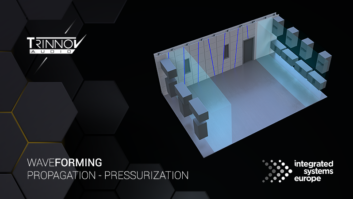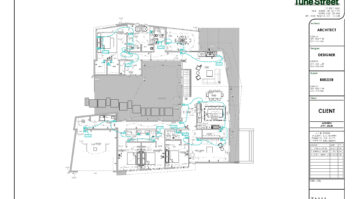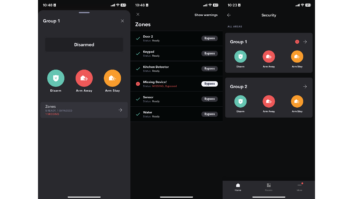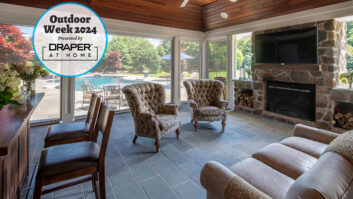Taking a look at modern electronic necessitiescellular telephones, blackberries, laptops, and even iPodsthere is one omnipresent feature: the keypad. At least as old as the first typewriter, which dates back to the late 18th century, the keypad is a tactile form of unlocking somethingbe it thoughts or actual doors. It is fitting, then, that a keypad be as simple in design and functionality as another ubiquitous necessity, the key itself.
It is that familiarity that makes keypads one of the best points of entry for those becoming acquainted with a home automation system. Relatively small, designed with hard, explicitly labeled buttons, keypads translate common sense into instant gratificationsomething that takes its more high-tech counterpart, the touchpanel, a few more button presses to deliver.
When you are walking in the door with a bag full of groceries one thing you dont want to have to do is navigate through a touchpanel to put on your lights, said Rich Blake, engineering manager for Lutron Electronics. In terms of ergonomics, the hard, fixed-button keypad is, in many instances, a superior solution in that application [because] it is always there, and it only does one thing. While that seems constraining, in a lighting control system that is actually a pretty good thing.
The challenge with most inherently simple and simply designed products like a keypad is the possibility of either leaving functionality and aesthetics too basic or making the product overly complicated. Over the last several years, control system manufacturers have done a great job of giving customers just what they want, how they like it, at a price point (rarely costing more than $400) that keeps keypads as relevant as any other major development in the residential systems market.
Some of the key things in keypad design include giving the user very easy access to things they want to use most, said Andy Lewis, Russounds product manager. We are always balancing adding more features with not obscuring the important features. As product managers, that is really our role. Engineers can create more and more complex things, lots of buttons, lots of options, but many of them never get used. So you just make it more difficult to access the things you want more quickly. Were looking out for the user.
Russound employs a rather unique way of linking its design sensibilities with the needs of its end users. Utilizing user-ability studies and paper prototyping, the company corrals a panel of real consumers (Russound employees are not permitted as test takers) and walks them through different concepts that could have an effect on how useable a keypad is. The reason you do paper protyping, is for one thing, it is very rapid, but also the people that are doing the testing are much more likely to give you input, Lewis explained. The more finished the prototype you are using looks, the less likely they are to give you any input or criticism.
For Russound, the result has been the well-received UNO line of keypads, which now includes a touchscreen/hard-button model, the UNO-TS2. First appearing on the market five years ago, around the time of satellite radios growing popularity, the inclusion of a display for button-press feedback on the UNO-S2 has been a big seller for Russound in this meta-data-driven age. Suddenly, that advantage we had with the displays became that much more important as choices in content grew, Lewis added.
Along with Russound, other manufacturers including Crestron, Xantech, AMX, Remote Technologies Inc. (RTI), and relative U.S. newcomer, Square D Clipsal, all have keypads that feature LCD displays. Crestrons APAD keypad, along with being stylish and bi-directional, offers more complex control should the end-user be so inclined. We keep it pretty simple and its intuitive, said Crestrons marketing manager, Jeff Singer. But there is the added ability to go deeper into subpages and take control over deeper levels of functionalitymaybe it is balance, bass, and treble, or other presets. You would expect more of that functionality from a touchpanel that you inherently give up by going to a keypad.
Without a doubt, functionality is top of the list when it comes to keypad design, but aesthetics are increasingly becoming a factor. Blame or praise the interior designer whose voice is gaining more cache with homeowners, but aesthetics has prompted several clever and attractive keypad evolutions. Longtime market player, Xantech, which can lay claims to being one of the first companies to derive an IR-based keypad, now has a range of keypads that feature different faceplates. You can interchange the whole front of that keypad to, number one, match any dcor, but also any functionality that the customer is looking for, said Xantechs Rich Seegull of the companys Smartpad series, which includes the SmartpadLCD. We have 12 different types of snap-in key modules that can be configured into the basic keypad system. We made it into a two-part keypad system. There is the base keypad module that goes into the wall and then there is the faceplate that snaps on to the module.
Lutron, whose keypad design philosophy is founded on the three-legged pedestal of ergonomics, cognition, and aesthetics, sees its SeTouch as fully embracing all three touchstones to set it apart. Along with a backlit button, Lutrons SeTouch also offers customized button labelinga complicated engineering feat that includes the engraving of different button colors, painting processes, as well as laser inscribing of foreign languages such as Chinese, Japanese, and German onto its buttons.
RTI, which carries a range of in-wall controllers that feature a mix of hard buttons and LCD displays, is zeroing in on keypads early in the first quarter of next year with a new, hard-button-only line. The RKI series of keypads were well received by dealers and distribution partners alike at CEDIA, said RTIs Pete Baker. The RKI keypads offer a very open platform and a wide variety of control options. Those perks include labels courtesy of RTI, which are affixed to the button underneath its cover, a 64-color spectrum of backlight choices, and three different versions of the keypad itself: the RKI-2 (two buttons), RKI-4 (four buttons), and the eight-button RKI-8.
Square D Clipsal, born in Australia before being acquired by Schneider Electric, has brought a Euro-Asian design sensibility to bear on the market. With its brightly lit and glass-encased offeringsthe Neo and Saturn keypads, respectivelySquare D hopes to raise the design bar on North American shores. What we have seen in the Australian, Asian, and European markets is ahead of the U.S. marketplace in design and adoption of advance lighting control systems, said David Bruce, national sales manager for the company. [There] you see more lighting control system in mid-range homes, whereas here in the U.S. you are not really seeing that yet.
While the Neo and Saturn models thrive on their sleek, visual appeal, Square D is also enthusiastic about its keypads that feature Dynamic Labeling Technology (DLT), which incorporates editable LCD labels that are available for each button or control group. The buttons can also display text, symbols, or graphics. It actually gives you eight different loads, so you can actually have eight different controls in one keypad [at] the standard size of a keypad, Bruce noted. Often times the first page would be used for different lighting scenes or rooms, and the second page would be audio control.
Although they inhabit their own niche, touchpanels have pushed keypad development to greater heights. As the manufacturers mentioned here have shown, the ability to offer visual feedback for corresponding button presses has resulted in most keypads now having some kind of LCD or LED screen for that purpose. It is inevitable, then, that the bridge between the two control methods will be traversed, upping the functionality ante as far as either category would allow.
Hybrid modelsthose that fall within the keypad form factor, yet offer the deeper functionality and design stylings of touchpanelshave already arrived. AMXs Mio Modero DMS and DMS Pinnacle keypad feature a four-inch monochrome LCD display and two control optionsexternal pushbuttons and a slider control coupled with a touch overlay on the LCDthat gives access to everything from lighting control to meta-data derived from digital libraries. [The DMS line] features split screen, LCD view, and a slider much like an iPod, said AMX VP of product development, Robert Noble. It is a pseudo touchpanel. Just by touching the screen, that becomes a button press. It is a blended product that transcends the keypad or touchpanel.
The absolute latest hybrid sensation comes from ELAN, which did a flamenco dance at this years CEDIA EXPO in celebration of its new touchpad, the Ol. Branded as its own category, FIT (film interactive touchpad), the companys marketing communications manager, Rick Gratz said of the Ol: It combines the beautiful graphics and the touch-sensitive overlay of a touchpanel, and yet it has the fixed position of buttons, simplicity of programming, and the price of a keypad.
The Ol, with its 16-bit, 65,000 full-graphics OLED, choice of seven magnetized frame colors, the ability to slide in up to 108 different film overlay designs via a hinged door, and a three-tier entry point design (Level 1 is a 13-button design, Level 2 offers 17 buttons, and Level 3 maxes out at 25 buttons), does literally standout. And while some might debate its status as a keypad, the Ols $380 price tag secures its place in the keypad category. For $80 above the average keypad price point, end users get incredible aesthetic flexibility and product functionality. The basic reasoning behind Ol to begin with is that our dealers are looking for a way to really customize each and everyone of their systems for a particular client, Gratz said. And to date, the only way to really do something like that is to specify touchpanels in their systems, where they can use custom graphics, customized layouts, and custom colors to do that. The problem there is that you are talking about starting at a MSRP of $1,000 on up to $10,000 to do something like that.
The Ol, along with similar hybrid offerings soon to come from the likes of Russound, marks the evolution of the category without putting it on the verge of extinction. In fact, the future of keypads includes familiar design statements like hard buttons and a minimal hogging of wall real estate as well as very 21st century upgrades like wireless interactivity with other devices, the ubiquity of integrated touchscreens, and the design influence of end users ever-changing aesthetic tastes.
Llanor Alleyne is managing editor of Residential Systems in New York City.







